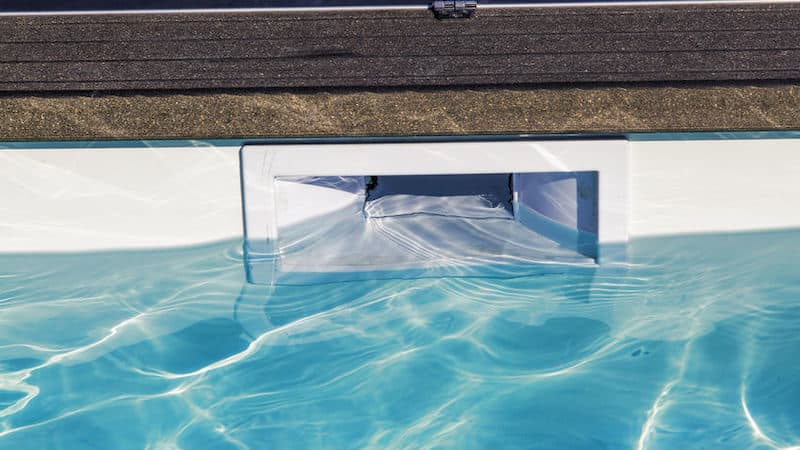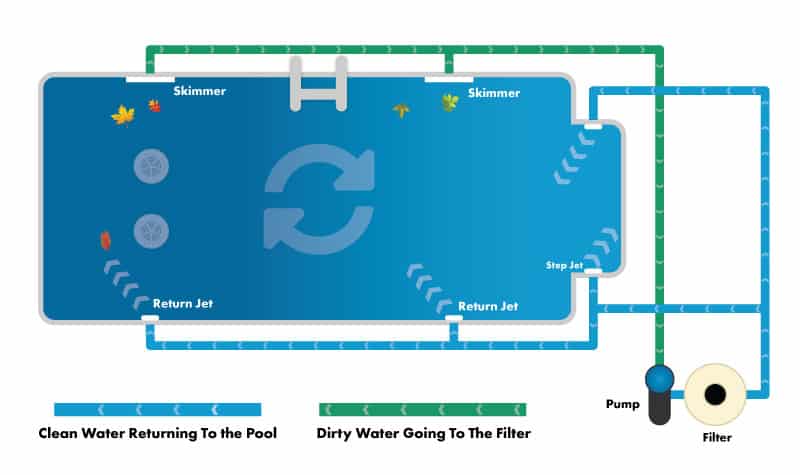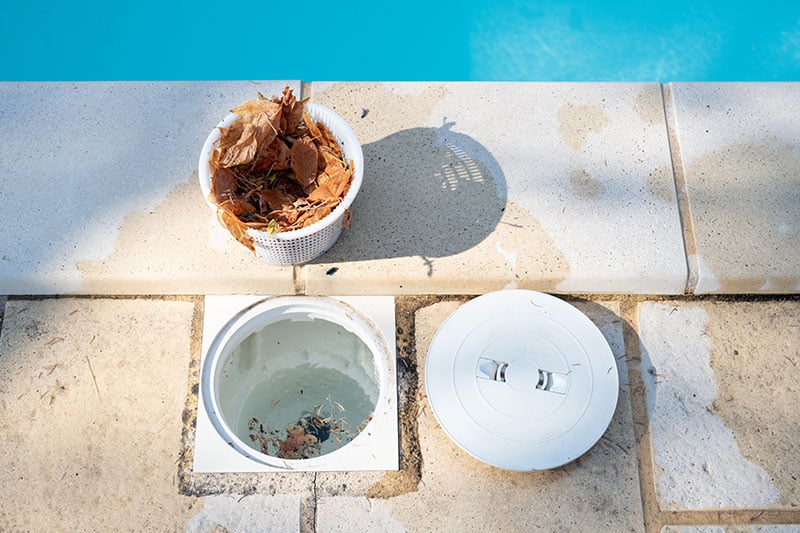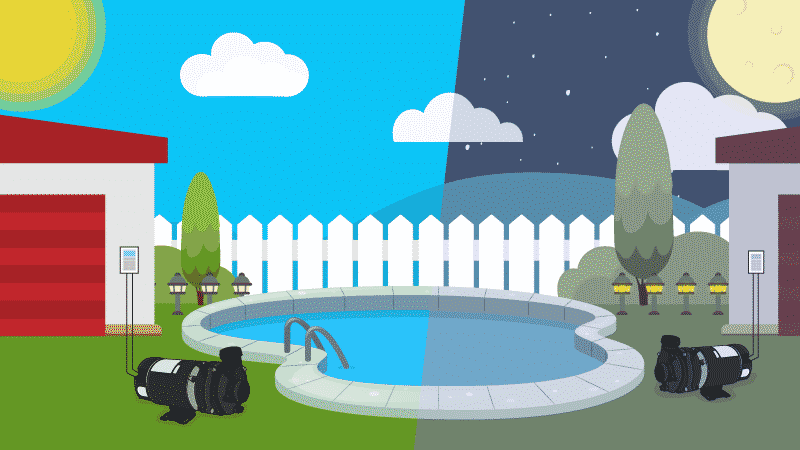What is a Pool Skimmer? (How to Clean and Troubleshooting Tips)
There are two types of pool skimmers. One is the skimmer net you attach to a telescopic pole used to get leaves and debris out of your pool. The other is a built-in skimmer attached to the side of your pool and acts as the entryway to your pump and filter.
Both are important elements in pool cleaning. But in this article, we’re talking about the ones attached to the side of your pool. As a pool owner, you’ll learn how they work, how to keep them clean and running properly, and how to troubleshoot them when things go wrong.
Stop wasting time and money with confusing water chemistry and maintenance. Our effortless system guarantees to keep your pool balanced, sanitized, and crystal clear all year. Works for all pools including saltwater.
What are Pool Skimmers?
Pool skimmers are like little buckets built into the side of the pool. They hold skimmer baskets, which perform a similar function to the handheld leaf skimmer. They keep leaves and floating debris from entering your pump and filter.
These are usually rectangular-shaped and are placed around the swimming pool, toward the tops of the walls. The water level usually covers about the bottom half of the skimmers.

They’re most often made of white plastic, and some have a door called a weir over the front that opens and closes according to the water level and movement.
Do You Need a Skimmer Weir Door? And How Pool Weirs Work?
Short answer: not really, so don’t worry about it if you don’t have one installed. They tend to break easily. But they’re useful. A floating skimmer weir is a gate that keeps surface debris the skimmer collects from going back into the pool when the pump’s off. It also regulates the amount of water entering the skimmer when the pump is running and helps trap the debris it collects.
How Do Pool Skimmers Work?
Pool skimmers are the starting point of pool circulation and act as a gateway to your pool’s filtration system. They’re the beginning of the suction line of your pool.
Your pool pump sucks water into the skimmers. As the water passes through the skimmer basket, it’s cleared of larger debris that would cause a blockage if it made it all the way to your pump or filter.
It also allows the filter to do its job of pulling the smaller contaminants out so the water that makes its way back into your pool through the returns is cleaner.

The skimmer also helps keep your pump and filter in tip-top shape by ensuring the water that passes through them is clear of things that could cause major problems for that expensive equipment.
Skimmers Keep The Swimming Pool Surface Clean
The more people who swim, the more sunscreen, makeup, shampoo, soap, and other non-living contaminants are left in the water. To help your filter out, you can increase your skimmer basket’s effectiveness by covering it with pantyhose. The finely knit fabric will catch some of the smaller debris that would normally tax your filter.
Do you think putting pantyhose on your skimmer is weird? Luckily for you, there’s something made exactly for that purpose: pool skimmer filter socks. They’ll do the same thing as pantyhose, but look more pool-like.
Designed to fit most pool skimmer baskets, it offers a protective layer to prevent pump impeller and shaft seal damage by trapping leaves, grass, hair, and other debris.
Skimmers Are A Place For Adding Chlorine Tablets
You could buy a floating chlorine dispenser or install an automatic chlorinator. If you use chlorine tablets to sanitize your pool, we recommend an automatic chlorinator. It’s the best way to add and control chlorine usage.
But if you don’t have one installed yet, you could just add a few chlorine tablets directly to your skimmer basket. Note: we do not recommend doing this for the long term. It can damage your pool equipment since the tablet dissolves concentrated chlorine that passes through your pump and filter.
However, we think it’s better than using a floating chlorine dispenser. Water is pulled through the skimmer and run over the tablets. This dissolves them more quickly than if they were just floating around the pool. This means a higher concentration of chlorine in your water, which translates to cleaner, more sanitary water.
NOTE: Just make sure you remove the partially dissolved tablets from the pool skimmer when your pump isn’t running to keep the highly chlorinated water from sitting in one place, possibly damaging equipment.
Invest in an automatic chlorinator. A chlorinator is the most efficient and safest way to add chlorine to your pool. With all that said, we highly recommend not adding any pool chemicals through your skimmers.
This automatic chlorinator is perfect for the pool owner who hates fussing with chlorine tablets. With its dial control valve, you can easily adjust the chlorine level depending on your pool's size.
Manual Pool Vacuuming
It’s great if you have an automatic pool cleaner, but there will be times when you’ll need to vacuum your pool manually. When that happens, you can put your pool’s circulation system to work.
Once you have your vacuum put together, you can insert the vacuum hose into the skimmer’s suction hole or use a skimmer vacuum plate. The water will be forced through the pool’s filter system as you vacuum, resulting in cleaner, clearer water.
Want to learn how to vacuum your pool manually? Click here.
When to Clean Your Pool Skimmer
Clean out your pool skimmer at least once a week. The basket catches all the debris that falls into your pool. The longer it sits in the pool, the higher the probability it’ll start to break up and then decay, and then you’ll have tiny, nasty bits floating around in your water.
Also, if you don’t skim debris off the water surface fast enough, the debris will sink to the bottom. This can cause staining and other water issues. So, it’s important to keep debris out of your pool water at all times.
Check the skimmer basic more often if…
- You have a lot of trees in your backyard.
- It’s been windy.
- You’ve had storms
- Any other condition exists that gives you a reason to believe your skimmer may fill up with debris pretty quickly.
How to Clean Your Pool Skimmer
All you have to do is take the skimmer lid, reach in, pull the basket out, and discard whatever is in the basket. Then put it back in the skimmer, replace the cover, and you’re done.

If the basket looks dingy, or it’s caught some particularly yucky things (dead bugs, anyone?), you can give it a spray with the hose before replacing it. If you feel it needs to be cleaned further than that, a mild multi-purpose spray will do the trick.
Important: Make sure you rinse the cleaner completely, or you may end up with foamy bubbles in your pool water and a bigger problem than you started with.
All Purpose Cleaner effectively cleans and degreases inside and outside of the home.
How to Unclog a Pool Skimmer Line
There are a few signs it might be clogged:
Your pool pump is pulsing or unusually loud, and the pressure is low.
If water is surging or pulsing in your pump, this may be a sign of a clogged pipe. But first, you have to rule out other potential problems, like air leaks. Check the o-ring on your pump lid. Then check to see if the impeller inside your pump is clogged.
Be sure the pump is off when you check this. And if you need help troubleshooting your pump, be sure to check our other videos. It may also be time to backwash or clean your filter if you haven’t done that in a while. If you have just cleaned your filter, that may have caused an air pocket to form. Remove the pump lid and basket and stick a hose inside to fill up the line with water.
Your water intake into your pump is slow, even if the skimmer basket is empty.
If water is slowly coming into your pool pump, check the skimmer door to make sure it isn’t stuck. Also, make sure your pool’s water level is halfway up the skimmer. If the skimmer door and water level look good, you may have a clog in your skimmer line.
To find out which pipe is blocked, run your pool pump and check each line one at a time. You can do this by using your pool diverter valve, aka a Jandy Valve. Switch the valve between the skimmers and the main drain lines.
If one line has low pressure or your pump loses suction, that means it’s clogged with an air pocket or debris. As you test these lines, be sure always to leave one line open. You never want to run your pump with all of the intake valves closed and no water flowing.
1. Try Moving The Pool Diverter Valve Back And Forth
Opening and closing the pool diverter valve while the pump is running may dislodge whatever is blocking your skimmer line. Shimmy the diverter valve back and forth between the lines for several seconds each time.
After several rounds of opening and closing the skimmer valve, you may remove the air pocket or dislodge the debris into the pump strainer basket. As we said, be sure to always leave one line open during this process so there’s water flowing to your pump as it runs.

2. Clear The Blockage With A Drain Cleaning Bladder
Drain cleaning bladders attach to your garden hose and are then inserted into the clogged line. When the hose is turned on, the bladder expands and pushes pressurized water down the pipe.
The emergency drain solution features a water pulsating valve to unclog blocked drains quickly. Clears slow and clogged drains with water power for your pool skimmer.
First, shut off your pump completely. Make sure your diverter valve is turned to the skimmer line.
Then, remove your skimmer basket. Insert the hose with the bladder attachment into the suction hole of your skimmer. Push it in as far as it will go.
When you turn on the hose, the bladder will expand while it’s in the pipe. That pressurized water will push any debris and air to the pump.

If that doesn’t work, try using the drain cleaning bladder in the pump. Make sure the pump is still off and the diverter valve is set to the skimmer line. Remove the pump basket and insert the hose with the bladder into the pump’s intake pipe that flows back towards the pool. This will force pressurized water back into the skimmer. Keep an eye out for debris that blows back to the skimmer.
You will also want to use the bladder in the pump if you have a clog in your main drain line. Just make sure the diverter valve is turned to the main drain when you do this.
If nothing else works, it might be time to call a pool professional to come to unclog your lines. But don’t give up right away: it can take several rounds of diverting water or using the bladder to unclog your lines.
The Skimmer in Winter
Whether you’re closing an inground pool or winterizing an above ground pool, you won’t want to skip the skimmer prep. Or you could open your pool to a bit of a mess next season.
For inground pool skimmers, once you’ve blown out the lines, you’ll need to insert a rubber plug or an ice compensator like a Gizzmo into your skimmer to keep it closed and prevent anything from sneaking into your filtration system over the winter.
Same goes for above ground pool skimmers. But in that case, depending on the type of skimmer you have, you may be able to just install a cover over it.
Either way, make sure you take care of your skimmer so it can keep taking care of your pool when you open it back up.
Screws into the bottom of the skimmer to absorb the expansion of winter freeze-up and is perfect for big, deep skimmers.
Frequently Asked Questions About Pool Skimmers
Here are some common questions we get about pool skimmers and how to use them.
Do you really need a skimmer in a pool?
Smaller above ground (Intex, Quick-Set, Blow-up, or stock tank) pools sometimes won’t come with built-in skimmers. But most pools need skimmers to help trap large surface debris from entering your pump so it doesn’t clog and run dry.
Is a pool skimmer the same as a filter or pool pump?
No. A pool skimmer simply “skims” the surface debris with a built-in basket before it enters your pool pump and then into your filter. Your pump also includes a basket to help trap debris your skimmer wasn’t able to collect.
How do you clean a pool skimmer, and how often?
Simply remove the skimmer cover, reach in and pull out the basket. Turn it upside down and dump the debris as far away from your pool as possible so it doesn’t come back into the pool. Do this once a week or more if you have trees, a heavy storm, or high winds.
Is it better to put pool shock in the skimmer?
No. NEVER add pool shock to your skimmer. If you have an automatic chlorinator installed, the shock will react with the chlorine tablets inside and cause an explosion. This is very dangerous. Always add shock directly to the pool water and NEVER through the skimmer.
Are there skimmers at the bottom of the pool?
If you have screens at the bottom of the pool, these are called main drains. Your pump pulls water in from them, but they are not skimmers. Skimmers are located at the top of the pool wall and contain a basket to help remove debris of the surface of the water.
4 Ways We Can Help With Your Pool
- Pool Care Cheat Sheets (Free): Easy-to-use downloadable guides to help you keep track of taking care of your pool this year.
- The Pool Care Handbook: An illustrated guide to DIY pool care, including water chemistry, maintenance, troubleshooting, and more.
- The Pool Care Video Course: You’ll get 30+ step-by-step videos and a downloadable guide with everything you need to know about pool maintenance.
- The Pool Care App: Enter your water test results. Get a custom treatment plan. Know exactly what chemicals to add to keep your pool clear.














